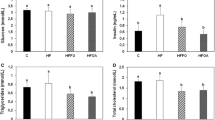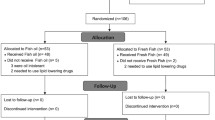Abstract
Fish are a rich source of eicosapentaenoic acid (EPA) and docosahexaenoic acid (DHA), two long-chain polyunsaturated n-3 fatty acids (LC n-3 PUFA) with cardiovascular benefits. A related but less-investigated LC n-3 PUFA, docosapentaenoic acid (DPA), is more common in seal oil and pasture-fed red meats. This study compared indicators of platelet function and plasma lipids in healthy volunteers given supplements containing these different fatty acids (FA) for 14 days. Subjects, randomised into three groups of ten, consumed capsules of tuna oil (210 mg EPA, 30 mg DPA, 810 mg DHA), seal oil (340 mg EPA, 230 mg DPA, 450 mg DHA) or placebo (sunola) oil. Supplementary LC n-3 PUFA levels were approximately 1 g/day in both fish and seal oil groups. Baseline dietary FA and other nutrient intakes were similar in all groups. Both fish and seal oil elevated platelet DHA levels (P < 0.01). Seal oil also raised platelet DPA and EPA levels (P < 0.01), and decreased p-selectin (P = 0.01), a platelet activation marker negatively associated with DPA (P = 0.03) and EPA (P < 0.01) but not DHA. Plasma triacylglycerol decreased (P = 0.03) and HDL-cholesterol levels increased (P = 0.01) with seal oil only. Hence, seal oil may be more efficient than fish oil at promoting healthy plasma lipid profiles and lowering thrombotic risk, possibly due to its high DPA as well as EPA content.

Similar content being viewed by others
Abbreviations
- AA:
-
Arachidonic acid
- ADP:
-
Adenosine diphosphate
- ANOVA:
-
Analysis of variance
- ATP:
-
Adenosine triphosphate
- BMI:
-
Body mass index
- cAMP:
-
Cyclic adenosine monophosphate
- CRP:
-
C-reactive protein
- CVD:
-
Cardiovascular disease
- DHA:
-
Docosahexaenoic acid
- DPA:
-
Docosapentaenoic acid
- EPA:
-
Eicosapentaenoic acid
- FA:
-
Fatty acid(s)
- HDL:
-
High density lipoprotein
- LC n-3 PUFA:
-
Long-chain omega-3 polyunsaturated fatty acids
- LDL:
-
Low density lipoprotein
- MPV:
-
Mean platelet volume
- MUFA:
-
Monounsaturated fatty acids
- SD:
-
Standard deviation
- Ω:
-
Ohm (electrical resistance)
References
Australian Bureau of Statistics (2008) Causes of Death 2006. Publication No. 3303.0. Australian Bureau of Statistics, Government Publisher, Canberra, Australia
De Lorgeril M (2007) Essential polyunsaturated fatty acids, inflammation, atherosclerosis and cardiovascular diseases. Subcell Biochem 42:283–297
Australian Institute of Health, Welfare (AIHW) (2004) Heart, stroke and vascular diseases: Australian facts 2004 (Cardiovascular Disease Series No. 22). Australian Institute of Health and Welfare and National Heart Foundation of Australia, Canberra
Wierzbicki AS (2005) Have we forgotten the pivotal role of high-density lipoprotein cholesterol in atherosclerosis prevention? Curr Med Res Opin 21:299–306
Pentikainen MO, Oorni K, Ala-Korpela M, Kovanen PT (2000) Modified LDL—trigger of atherosclerosis and inflammation in the arterial intima. J Intern Med 247:359–370
Colwell J (2000) Pathogenesis of vascular disease. Diabetes Obes Metab 2(Suppl 2):S19–S24
Rivera J, Lozano ML, Navarro-Nūňez L, Vicente V (2009) Platelet receptors and signalling in the dynamics of thrombus formation. Haematologica. (in press)
Ruggeri ZM (2002) Platelets in atherothrombosis. Nat Med 8:1227–1234
Fabre JE, Nguyen M, Athirakul K, Coggins K, McNeish JD, Austin S, Parise LK, FitzGerald GA, Coffman TM, Koller BH (2001) Activation of the murine EP3 receptor for PGE2 inhibits cAMP production and promotes platelet aggregation. J Clin Invest 107:603–610
Massaro M, Scoditti E, Carluccio MA, De Caterina R (2008) Basic mechanisms behind the effects of n-3 fatty acids on cardiovascular disease. Prostaglandins Leukot Essent Fatty Acids 79:109–115
Kinsella JE, Lokesh B, Stone RA (1991) Dietary n-3 polyunsaturated fatty acids and amelioration of cardiovascular disease: possible mechanisms. Am J Clin Nutr 53:177–178
Deutch B, Jørgensen E, Hansen J (2000) N-3 PUFA from fish or seal oil reduce atherogenic risk indicators in Danish women. Nutr Res 20:1065–1077
Pirich C, Gaszo A, Granegger S, Sinzinger H (1999) Effects of fish oil supplementation on platelet survival and ex vivo platelet function in hypercholesterolemic patients. Thromb Res 96:219–227
Albert CM, Hennekens CH, O’Donnell CJ, Ajani UA, Carey VJ, Willett WC, Ruskin JN, Manson JE (1998) Fish consumption and risk of sudden cardiac death. JAMA 279:23–28
Weber P, Raederstorff D (2000) Triglyceride-lowering effect of omega-3 LC–polyunsaturated fatty acids: a review. Nutr Metab Cardiovasc Dis 10:28–37
Dewailly E, Blanchet C, Gingras S, Lemieux S, Holub BJ (2003) Fish consumption and blood lipids in three ethnic groups in Québec (Canada). Lipids 38:359–365
Nomura S, Kanazawa S, Fukuhara S (2003) Effects of eicosapentaenoic acid on platelet activation markers and cell adhesion molecules in hyperlipidemic patients with Type 2 diabetes mellitus. J Diabetes Complicat 17:153–159
Nomura S, Inami N, Shouzu A, Omoto S, Kimura Y, Takahashi N et al (2009) The effects of pitavastatin, eicosapentaenoic acid and combined therapy on platelet-derived microparticles and adiponectin in hyperlipidemic, diabetic patients. Platelets 20:16–22
Harris WS, Miller M, Tighe AP, Davidson MH, Schaefer EJ (2008) Omega-3 fatty acids and coronary heart disease risk: clinical and mechanistic perspectives. Atherosclerosis 197:12–24
Howe PRC, Meyer BJ, Record S, Baghurst K (2003) Contribution of red meat to dietary intakes of polyunsaturated fatty acids. Confidential Report to meat and livestock Australia
Astorg P, Arnault N, Czernichow S, Noisette N, Galan P, Hercberg S (2004) Dietary intakes and food sources of n-6 and n-3 PUFA in French adult men and women. Lipids 39:527–535
Hino A, Adachi H, Toyomasu K, Yoshida N, Enomoto M, Hiratsuka A, Hirai Y, Satoh A, Imaizumi T (2004) Very long chain n-3 fatty acid intake and carotid atherosclerosis: an epidemiological study evaluated by ultrasonography. Atherosclerosis 176:145–149
Joensen AM, Schmidt EB, Dethlefsen C, Johnsen SP, Tjønneland A, Rasmussen LH, Overvad K (2010) Dietary intake of total marine n-3 polyunsaturated fatty acids, eicospentaenoic acid, docosahexaenoic acid and docosapentaenoic acid and the risk of acute coronary syndrome—a cohort study. Br J Nutr 103:602–607
Howe P, Meyer B, Record S, Baghurst K (2006) Dietary intake of long-chain omega-3 polyunsaturated fatty acids: contribution of meat sources. Nutrition 22:47–53
McLennan W, Podger A (1997) National Nutrition Survey, Selected Highlights, Australia. Australian Government Publishing Service, Canberra
Cheryk LA, Conquer JA, Holub PA, Gentry PA (1999) Docosahexaenoic acid and docosapentaenoic acid incorporation into human platelets after 24 and 72 hours: Inhibitory effects on platelet reactivity. Platelets 10:203–211
Akiba S, Murata T, Kitatani K, Sato T (2000) Involvement of lipoxygenase pathway in docosapentaenoic acid-induced inhibition of platelet aggregation. Biol Pharm Bull 23:1293–1297
Rissanen T, Voutilainen S, Nyyssönen K, Lakka TA, Salonen JT (2000) Fish oil-derived fatty acids, docosahexaenoic acid and docosapentaenoic acid, and the risk of acute coronary events: the Kuopio Ischaemic Heart Disease Risk Factor Study. Circulation 102:2677–2679
Conquer JA, Cheryk LA, Chan E, Gentry PA, Holub BJ (1999) Effect of supplementation with dietary seal oil on selected cardiovascular risk factors and hemostatic variables in healthy male subjects. Thromb Res 96:239–250
Bjørkkjaer T, Brunborg LA, Arslan G, Lind RA, Brun JG, Valen M, Klementsen B, Berstad A, Frøyland L (2004) Reduced joint pain after short-term duodenal administration of seal oil in patients with inflammatory bowel disease: comparison with soy. Scand J Gastroenterol 39:1088–1094
Arslan G, Brunborg LA, Frøyland L, Brun JG, Valen M, Berstad A (2002) Effects of duodenal seal oil administration in patients with inflammatory bowel disease. Lipids 37:935–940
Brunborg LA, Madland TM, Lind RA, Arslan G, Berstad A, Frøyland L (2008) Effects of short-term oral administration of dietary marine oils in patients with inflammatory bowel disease and joint pain: a pilot study comparing seal oil with cod liver oil. Clin Nutr 27:614–622
Murphy KJ, Chronopoulos AK, Singh I, Francis MA, Moriarty H, Pike MJ, Turner AH, Mann NJ, Sinclair AJ (2003) Dietary flavanols and procyanidin oligomers from cocoa (Theobroma cacao) inhibit platelet function. Am J Clin Nutr 77:1466–1473
Freidewald WT, Levy RI, Fredrickson DS (1972) Estimation of the concentration of LDL-cholesterol in plasma without the use of the preparative ultracentrifuge. Clin Chem 18:499–502
Blank C, Neumann MA, Makrides M, Gibson RA (2002) Optimizing DHA levels in piglets by lowering the linoleic acid to alpha-linolenic acid ratio. J Lipid Res 43:1537–1543
Kaur G, Begg D, Barr D, Garg M, Cameron-Smith D, Sinclair A (2010) Short-term docosapentaenoic acid (22:5 n-3) supplementation increases tissue docosapentaenoic acid, DHA and EPA concentrations in rats. Br J Nutr 103(1):32–37
Russo GL (2009) Dietary n-6 and n-3 polyunsaturated fatty acids: from biochemistry to clinical implications in cardiovascular prevention. Biochem Pharmacol 77:937–946
Mozaffarian D, Ascherio A, Hu FB, Stampfer MJ, Willet WC, Siscovick DS, Rimm EB (2005) Interplay between different polyunsaturated fatty acids and risk of coronary heart disease in men. Circulation 111:157–164
Park Y, Harris W (2002) EPA, but not DHA, decreases mean platelet volume in normal subjects. Lipids 37:941–946
Brox J, Olaussen K, Osterud B, Elvevoll EO, Bjørnstad E, Brattebøg G, Iversen H (2001) A long-term seal- and cod-liver-oil supplementation in hypercholesterolemic subjects. Lipids 36:7–13
Swann PG, Venton DL, Le Breton GC (1989) Eicosapentaenoic acid and docosahexaenoic acid are antagonists at the thromboxane A2/prostaglandin H2 receptor in human platelets. FEBS Lett 243:244–246
Phang M, Garg ML, Sinclair AJ (2009) Inhibition of platelet aggregation by omega-3 polyunsaturated fatty acids is gender-specific—redefining platelet response to fish oils. Prostaglandins Leukot Essent Fatty Acids 81:35–40
Buckley R, Shewring B, Turner R, Yaqoob P, Minihane AM (2004) Circulating triacylglycerol and apoE levels in response to EPA and docosahexaenoic acid supplementation in adult human subjects. Br J Nutr 92:477–483
Thomas TR, Smith BK, Donahue OM, Altena TS, James-Kracke M, Sun GY (2004) Effects of omega-3 fatty acid supplementation and exercise on low-density lipoprotein and high-density lipoprotein subfractions. Metabolism 53:749–754
Osterud B, Elvevoli E, Barstad H, Brox J, Halvorsen H, Lia K et al (1995) Effect of marine oils supplementation on coagulation and cellular activation in whole blood. Lipids 30:1111–1118
Wilkinson P, Leach C, Ah-Sing EE, Hussain N, Miller GJ, Millward DJ, Griffin BA (2005) Influence of [alpha]-linolenic acid and fish-oil on markers of cardiovascular risk in subjects with an atherogenic lipoprotein phenotype. Atherosclerosis 181:115–124
Bonefeld-Jorgensen EC, Moller SM, Hansen JC (2001) Modulation of atherosclerotic risk factors by seal oil: a preliminary assessment. Int J Circumpolar Health 60:25–33
Myer BJ, Lane AE, Mann NJ (2009) Comparison of seal oil to tuna oil on plasma lipid levels and blood pressure in hypertriglyceridaemic subjects. Lipids 44:827–835
Park Y, Harris WS (2003) Omega-3 fatty acid supplementation accelerates chylomicron triglyceride clearance. J Lipid Res 44:455–463
Malle E, Kostner G (1993) Effects of fish oil on lipid variables and platelet function indices. Prostaglandins Leuko Essent Fatty Acids 49:645–663
Yoshida H, Mawatari M, Ikeda I, Imaizumi K, Seto A, Tsuji H (1999) Effect of dietary seal and fish oils on triacylglycerol metabolism in rats. J Nutr Sci Vitaminol (Tokyo) 45:411–421
Balk EM, Lichstenstein AH, Chung M, Kupelnick B, Chew P, Lau J (2006) Effects of omega-3 fatty acids on serum markers of cardiovascular disease risk: a systematic review. Atherosclerosis 189:19–30
Micallef MA, Munro IA, Garg ML (2009) An inverse relationship between plasma n-3 fatty acids and C-reactive protein in healthy individuals. Eur J Clin Nutr 63:1154–1156
Acknowledgments
We gratefully acknowledge the time and effort contributed by the study volunteers. This study was funded through a research grant from Meat & Livestock Australia (MLA).
Author information
Authors and Affiliations
Corresponding author
Additional information
This study was supported by a grant from Meat and Livestock Australia (MLA).
About this article
Cite this article
Mann, N.J., O’Connell, S.L., Baldwin, K.M. et al. Effects of Seal Oil and Tuna-Fish Oil on Platelet Parameters and Plasma Lipid Levels in Healthy Subjects. Lipids 45, 669–681 (2010). https://doi.org/10.1007/s11745-010-3450-z
Received:
Accepted:
Published:
Issue Date:
DOI: https://doi.org/10.1007/s11745-010-3450-z




